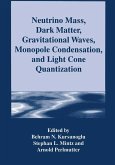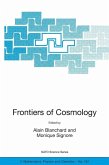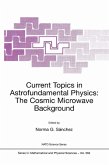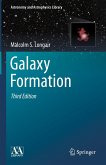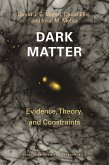For over ten years, the dark side of the universe has been headline news. Detailed studies of the rotation of spiral galaxies, and 'mirages' created by clusters of galaxies bending the light from very remote objects, have convinced astronomers of the presence of large quantities of dark (unseen) matter in the cosmos. Moreover, in the 1990s, it was discovered that some four to five billion years ago the expansion of the universe entered a phase of acceleration. This implies the existence of dark energy. The nature of these 'dark; ingredients remains a mystery, but they seem to comprise about 95 percent of the matter/energy content of the universe. As for ordinary matter, although we are immersed in a sea of dark particles, including primordial neutrinos and photons from 'fossil' cosmological radiation, both we and our environment are made of ordinary, baryonic matter. Strangely, even if 15-20 percent of matter is baryonic matter, this represents only 4-5 percent of the total matter/energy content of the cosmos.
Here, authors Alain Mazure and Vincent Le Brun present the inventory of matter, both baryonic and exotic, and investigate the nature and fate of matter's twin, anti-matter. According to the standard model, matter and anti-matter should have been formed in equal quantities. Yet there seems to have been a very slight asymmetry, as yet unexplained, where 100,000,001 particles of matter formed for every 100,000,000 particles of anti-matter! The authors show how developments in technology have led to significant progress in scientific research and how, in tandem with the evolution of new ideas, these advances are helping to lift the cosmic veil.
Here, authors Alain Mazure and Vincent Le Brun present the inventory of matter, both baryonic and exotic, and investigate the nature and fate of matter's twin, anti-matter. According to the standard model, matter and anti-matter should have been formed in equal quantities. Yet there seems to have been a very slight asymmetry, as yet unexplained, where 100,000,001 particles of matter formed for every 100,000,000 particles of anti-matter! The authors show how developments in technology have led to significant progress in scientific research and how, in tandem with the evolution of new ideas, these advances are helping to lift the cosmic veil.
Dieser Download kann aus rechtlichen Gründen nur mit Rechnungsadresse in A, B, BG, CY, CZ, D, DK, EW, E, FIN, F, GR, HR, H, IRL, I, LT, L, LR, M, NL, PL, P, R, S, SLO, SK ausgeliefert werden.
From the reviews:
"This complete, timely presentation explains why people can see only 4 percent of the universe. ... Well-selected color plates add to reader interest. A brief appendix, glossary of definitions, and index support the text. ... the book will appeal most to scientifically inclined senior undergraduates through professional readers ... . Summing Up: Highly recommended. Upper-division undergraduates and above." (W. E. Howard III, Choice, Vol. 49 (10), June, 2012)
"The aim of this book is ... to explain the concepts behind this revolution and allow the layman to understand the phenomena and measurements that enabled this new view to arise. With a layout as clear as the prose and a lavish use of illustrations, colour photographs, and line diagrams, the book is mostly successful in its aim. ... an excellent introductory astronomy text at A-level or first-year-undergraduate-level physics or indeed as a useful inspirational book for continuing-education courses." (Barry Kent, The Observatory, Vol. 132 (1229), August, 2012)
"The presentation of this popular text is very readable, it contains a lot of pictures, mainly of astronomical objects outside our galaxy, and explains several of the observational techniques and instruments. The main topic is modern cosmology, the relation between dark matter, dark energy, and anti-matter in the cosmos are discussed in details. The book contains almost no formula, even the blackbody radiation formula is replaced by a figure to explain the frequency distribution of the cosmic background radiation." (Hans-Jürgen Schmidt, Zentralblatt MATH, Vol. 1235, 2012)
"This complete, timely presentation explains why people can see only 4 percent of the universe. ... Well-selected color plates add to reader interest. A brief appendix, glossary of definitions, and index support the text. ... the book will appeal most to scientifically inclined senior undergraduates through professional readers ... . Summing Up: Highly recommended. Upper-division undergraduates and above." (W. E. Howard III, Choice, Vol. 49 (10), June, 2012)
"The aim of this book is ... to explain the concepts behind this revolution and allow the layman to understand the phenomena and measurements that enabled this new view to arise. With a layout as clear as the prose and a lavish use of illustrations, colour photographs, and line diagrams, the book is mostly successful in its aim. ... an excellent introductory astronomy text at A-level or first-year-undergraduate-level physics or indeed as a useful inspirational book for continuing-education courses." (Barry Kent, The Observatory, Vol. 132 (1229), August, 2012)
"The presentation of this popular text is very readable, it contains a lot of pictures, mainly of astronomical objects outside our galaxy, and explains several of the observational techniques and instruments. The main topic is modern cosmology, the relation between dark matter, dark energy, and anti-matter in the cosmos are discussed in details. The book contains almost no formula, even the blackbody radiation formula is replaced by a figure to explain the frequency distribution of the cosmic background radiation." (Hans-Jürgen Schmidt, Zentralblatt MATH, Vol. 1235, 2012)



